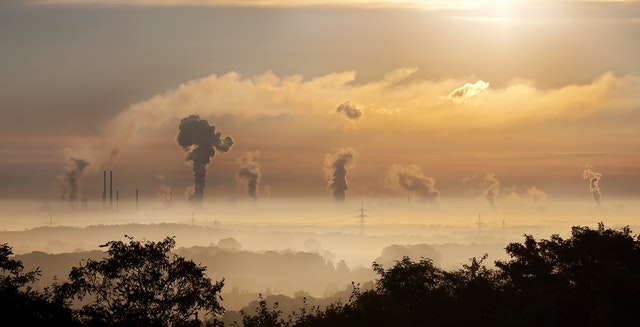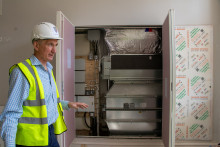An Interesting Green Week
Dr Andrew Cates, Bursar of Pembroke, reflects on this year's Green Week...
Tuesday 31 May 2022
Of course, we are in full swing on exams, and in the middle of a lot of other things, but this week has included a series of interesting environmental meetings on which I thought I might reflect.
Tuesday
This morning brought two meetings with banks.
There is a definite irony to talking with our banks about environmental concerns. My generation was deeply concerned about the environment and global warming, and in 1989 (when I was a graduate student) such student concern carried the Green Party (for whom many of us lobbied) to a record 14.5% of the vote in a Euro election. As we moved on, and started earning, ethical and green funds started being marketed to us, and we invested, believing it would make a difference. In the "noughties" (2000-2008) these funds outperformed the market and we felt green, ethical and smug.
Then in 2008 Gordon's banking crisis hit and to our astonishment most of our savings were wiped out. We had not realised that when you remove every company with an environmental footprint from the share index all you get left with are the banks, whose shares had just collapsed. We were unknowingly heavy investors in the banking sector. We worked out, in that crash, that they were not all ethical but were they also green?
How companies use banks for investment
Banks play a really important role in how the economy operates, but there are many strands to their role. The main environmental effect comes from lending money, which drives physical activity. Individual capital projects (say, a coal power station or a pipeline) and companies, both borrow money from banks to "gear" their activities. Gearing (the ratio of a company's debt-to-equity) is a key facilitator for projects. For example:
Scenario 1: Greedco pay for the construction of one power station from their own money. They then run it, sell the power and have to save up the proceeds to build the next one.
Scenario 2: Greedco have the money for one coal power station but set it up as an independent company borrowing 80% of money they need. They have only used 20% of their money and effectively borrow against future profit to pay to build more immediately. Greedco can now build five power stations, rather than just one .
If everyone divests from buying Greedco shares, it makes no difference to the company or marginally helps them; they don't care to whom they pay dividends. Divestment is often a pointless gesture. Greedcos make lots of money from environmental depletion or destruction so they don't ever need funding from shareholders and whoever buys the divested shares is less likely to constrain them. It doesn't have to be coal power stations, the same argument is true for planes, factories, plantations, cattle ranches, opencast mines and landfill sites.
Carbon intensity
So, we know how banks can cause destruction, the question is how to stop them, accidentally or deliberately, from doing this. What are the right targets? That quickly becomes very technical. They make lots of claims about things being "compatible with 1.5C warming" etc, but it is far from clear that the measures are effective.
The banks' current favourite measure is "carbon intensity": which is borrowed from power generation, where it means how many grams of carbon dioxide (CO2) it takes to produce one unit of electricity a kilowatt per hour (kW/hour). For a country's power needs, carbon intensity makes a lot of sense. The country needs a certain amount of power, then generates it with as little carbon emission as possible. Targeting this gets there by steadily reducing the carbon per kW/h with investment over a couple of decades.
Even in the power sector, if a bank keeps the same customers, the carbon intensity measure will make them look good even if they do nothing. For example, to its shame, Germany generates nearly 20% of its electricity by bulldozing virgin forest and open cast mining lignite (high sulphur low energy) coal for power. They have (after decades of refusal) got a plan to phase this out...completely by 2035. Should that show up as a huge reduction in carbon intensity for the banks who happen to fund them (and have for decades not squeaked once)?
But does the way they define "carbon intensity" as the CO2 produced per dollar lending of the portfolio of customers in a bank, make sense as a target to decrease CO2 globally? Not really, because although the total amount of power generated means something, the total amount of financed activity does not. It just amounts to a random selection of what’s going on and reducing things with a leaky measure is like trying to squeeze water with your fist.
This conversation needs to start with “what properties must a target have to make it useful”. A target is only “1.5% compliant” if, that target being fulfilled by everyone meant the planet would reach 1.5%.
Over the last three decades Shell have "divested" more than 85% of their oil refineries (they now only have five) - this was probably to avoid getting caught with stranded assets rather than to lower carbon intensity - but most of those refineries are still in existence, still generating lots of CO2. There is no change in the world's emissions, whilst they and their bank look good. Surely someone must be looking bad to compensate? Yes, but small national banks or private equity will pick up the debts or assets at a discount and never appear in the major bank figures. Meanwhile, while the bank is looking good for reasons outside their control (bonuses all round as Private Eye would say), they can continue to project finance bad projects, where they actually do have a direct impact, with impunity. The problem is that there is no simple aggregate figure which would work; embedded carbon and operating carbon need to be scaled to some aspect of their economic footprint. And complexity always provides the opportunity for the unscrupulous to kick up dust (what if your new polluting aircraft is cleaner than an old one you are retiring?).
A new way forward?
So perhaps Cambridge needs to take a lead in measures. I would start with creating a number of tokens equal to the amount of CO2 which we think the world can produce by 2050 and giving a fixed quota to new financed projects. Then we can start talking about how much the tokens are worth and whether the profit is worth it; and maybe get credit for closing down other stuff. Banks need to find a way to measure the physical changes they facilitate or cause, and it need third party auditing to confirm it.
Pembroke has a long history of engaging with banks. In 2016, when we first raised the funding of the Lakota Dakota pipeline with Barclays (they funded the "Energy Transfer Partnership" which was building it), their first response was, "Oh dear, are we expected to know what that is?" We had a series of meetings at increasingly senior level and were credited with some minor structural change within the central organization. Since then, we have been in continual dialogue.
The meetings with Lloyd's and Barclays were arranged by Ellen Quigley, who is the special adviser on the environment to the University of Cambridge's Finance Director, and a number of Bursars and Heads of House turned up. My personal view is that there is increasing daylight between the two banks. Lloyd's had a lower carbon starting position but is engaging with us, showing signs of wanting to think through their position, and asking for help in determining the way forward. Their CEO came to dinner recently with the Vice-Chancellor (VC) and a group of us, which was brave. Their big challenges are different anyway; as the biggest mortgager in the UK, they wonder how can they get housing stock decarbonised, when transition to heat pumps involves considerable capital outlay and higher running costs? Lloyd's are close to the point of convincing me that their top to bottom motivation to help with the carbon problem is genuine; given the complexity in monitoring what they do, that would be a great help. I have spent a lot of time in huge organisations and how they work in practice (versus what they say or think) is a favourite interest of mine.
Barclays took more of a PR-centric approach. Lots of people, glossy slides, a "batting it back" defensive style and not a lot of interest in admitting error or trying to find aggregate methods which actually worked. It felt like someone senior was trying to employ a fix, find a way of adding things up which made them look okay and not change the business. There was a lot of frustration and I was given a green light to roast them. Job done.
Wednesday
The College owns and leases out a couple of thousand acres of farmland. Today, I and seven or eight other bursars had a long and interesting morning watching presentations on environmental farming. I was particularly intrigued to learn more about how the change from an EU to a new UK subsidy and regulatory regime will work. If the government starts allowing genetically edited crops, should the landlord allow tenants to grow them? There are distinct and different cases, apparently. What about carbon offsetting on College land? It's not yet credible, even on the most credible claims (forestry - soil is the least credible) but there are some signs that the forward market might be coming good (we discussed, amongst other things, who gets the carbon credit if wood is grown, harvested and incorporated into a building; half a dozen different people might be claiming credit for the same atoms).
In my view, the minimum actual cost to offset will be £200/tonne. Current "best" schemes charge £20/tonne and are greenwash. However, I was very interested to learn that "no plough" farming, drilling seeds under the weeds, could give good yields within a few years whilst keeping much more carbon in the soil. The problems on compaction from heavy tractors might be managed by several smaller unmanned tractors. But I was equally depressed to discover that almost all farming with a reasonable yield involved nearly half a tonne of ammonium nitrate, with a couple of tonnes of carbon footprint, per hectare to work (including dairy). Perhaps much of food production can be moved into hydroponics eventually and nature left to do its stuff at lower yields on the fields.
Agriculture is a work in progress but I have a better appreciation of our role. The new government schemes to pay to increase diversity on land are interesting but there are still gaps...
Thursday
Today the focus was on the Mill Lane project, and all the interesting environmental aspects. It will be the first large-scale College project to use a huge air source heat pump for hot water and space heating (pushing out thirty thousand litres of cold air a second towards the underground car park of the University Centre... don't tell them, but it will be a bracing cold wind). Stupidly, environmentally the standard measures don't score it much better than electric panel heaters because mains electricity is supposed to be decarbonised for most of its lifetime... and hundreds of square metres of rooftop solar, by the same measure, are not given proper carbon credit. Measures, as ever, don't capture the reality; without new green power the 100% decarbonised target won't be attained, after all.
There was a site visit to see hand recovery of all the bricks for reuse and more discussion on embedded carbon in all of the glulam roof beams (credit gets marked on every scorecard).
Friday
Had a brief but pleasant break from other matters to talk to one of our Architectural students about how environmental considerations feature in the selection of architects and which consultants actually drive environmental impact of the development.
All in all, an interesting week from which I have learned much.
Images:
Photo by Lukas: https://www.pexels.com/photo/aerial-photography-of-green-pines-574190/
Dr Andrew Cates
Photo by Pixabay: https://www.pexels.com/photo/sky-clouds-building-industry-39553/
Photo by Pixabay: https://www.pexels.com/photo/agriculture-arable-barley-blur-265216/
Heating system in 4 Mill Lane




